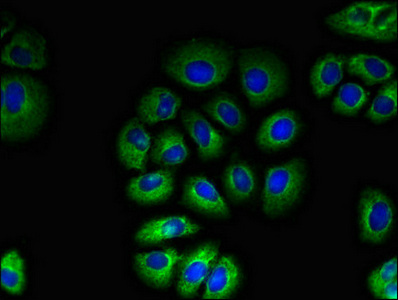-
货号:CSB-PA840577LA01HU
-
规格:¥440
-
促销:
-
图片:
-
其他:
产品详情
-
产品名称:Rabbit anti-Homo sapiens (Human) TAS1R2 Polyclonal antibody
-
Uniprot No.:Q8TE23
-
基因名:
-
别名:G protein coupled receptor 71 antibody; G-protein coupled receptor 71 antibody; GPR71 antibody; Sweet taste receptor T1R2 antibody; T1R2 antibody; TAS1R2 antibody; Taste receptor type 1 member 2 antibody; TR2 antibody; TS1R2_HUMAN antibody
-
宿主:Rabbit
-
反应种属:Human
-
免疫原:Recombinant Human Taste receptor type 1 member 2 protein (183-362AA)
-
免疫原种属:Homo sapiens (Human)
-
标记方式:Non-conjugated
本页面中的产品,TAS1R2 Antibody (CSB-PA840577LA01HU),的标记方式是Non-conjugated。对于TAS1R2 Antibody,我们还提供其他标记。见下表:
-
克隆类型:Polyclonal
-
抗体亚型:IgG
-
纯化方式:>95%, Protein G purified
-
浓度:It differs from different batches. Please contact us to confirm it.
-
保存缓冲液:Preservative: 0.03% Proclin 300
Constituents: 50% Glycerol, 0.01M PBS, pH 7.4 -
产品提供形式:Liquid
-
应用范围:ELISA, IF
-
推荐稀释比:
Application Recommended Dilution IF 1:50-1:200 -
Protocols:
-
储存条件:Upon receipt, store at -20°C or -80°C. Avoid repeated freeze.
-
货期:Basically, we can dispatch the products out in 1-3 working days after receiving your orders. Delivery time maybe differs from different purchasing way or location, please kindly consult your local distributors for specific delivery time.
引用文献
- A novel biomimetic electrochemical taste-biosensor based on conformational changes of the taste receptor Y Zou,Biosensors & bioelectronics,2024
相关产品
靶点详情
-
功能:Putative taste receptor. TAS1R2/TAS1R3 recognizes diverse natural and synthetic sweeteners.
-
基因功能参考文献:
- genetic association studies in population of preschool-aged children in Guelph, Ontario: Data suggest that SNPs in CD36 (rs1761667), TAS1R2 (rs35874116), and TAS2R38 (rs713598) are associated with snacking behavior in the population studied. [PILOT PROJECTS] PMID: 29385734
- We observe that binding of agonists to VFD2 of TAS1R2 leads to major conformational changes to form a TM6/TM6 interface between TMDs of TAS1R2 and TAS1R3, which is consistent with the activation process observed biophysically on the metabotropic glutamate receptor 2 homodimer. PMID: 28228527
- Alleles from each TAS1R2 locus (GG compared with AA alleles of rs12033832, and CT/CC compared with TT alleles of rs35874116) were related to higher consumption of carbohydrates (% energy) and higher amount of sweet foods, respectively (P<0.05). PMID: 29110749
- The molecular anatomy of sweet taste receptor dimers T1R2-T1R3 has been presented. PMID: 27936499
- no significant associations between GLUT2 and/or TAS1R2 polymorphisms and fillings were found, but allele frequencies of the TAS1R2 variant were marginally significantly different between children with DMFT = 0 and DMFT >/=1. no significant interaction between both genes and risk of dental caries was found. GLUT2 and TASR1 polymorphisms may influence the risk of caries in the Czech population PMID: 26112465
- In conclusion, the Val/Val genotype of TAS1R2 was associated with a higher carbohydrate intake and HTG. PMID: 26907331
- high-risk caries experience (>8 caries) was found to be associated with TAS1R2 rs35874116 homozygous polymorphic genotype. PMID: 25924601
- The rs12033832 single nucleotide polymorphism in TAS1R2 is associated with sucrose taste and sugar intake, but the effect differs depending on BMI PMID: 26279452
- human and mouse membrane trafficking systems for sweet taste receptors T1r2 and T1r3 PMID: 25029362
- effects of artificial sweeteners on adipose tissue may be largely independent of the classical sweet taste receptors, T1R2 and T1R3 PMID: 24068707
- Interaction between brazzein and the amino terminal domain of the sweet receptor subunit T1R2 showed a stronger interaction at 7 degrees C than at 37 degrees C.; the low temperature conformation, alters the orientations of 2 loops known to be critical for the sweetness of brazzein, may represent the bound state of brazzei in the complex with the human sweet receptor. PMID: 23349025
- associated with caries risk PMID: 23257979
- Genetic ablation of the sweet TR protein T1R2 obliterates fructose-induced insulin release and its potentiating effects on glucose-stimulated insulin secretion in vitro and in vivo. PMID: 22315413
- T1R2/T1R3 is involved in glucose-dependent secretion of satiation peptides PMID: 21540445
- Our findings show that a genetic variation in TAS1R2 affects habitual consumption of sugars and may contribute to interindividual differences in changing behaviors in response to dietary counseling. PMID: 20943793
- significant associations were seen in TAS1R2 for caries risk and/or protection. PMID: 20858777
- Data show that Positive allosteric modulators of the sweet taste receptor could help reduce the caloric content in food and beverages while maintaining the desired taste. PMID: 20173092
- Results from mutagenesis and chimeras of the receptor indicated that brazzein interacts with both T1R2 and T1R3 and that the Venus flytrap module of T1R2 is important for brazzein agonism. PMID: 20302879
- Interactions between the human sweet-sensing T1R2-T1R3 receptor and sweeteners detected by saturation transfer difference NMR spectroscopy. PMID: 19664591
- The mechanism of interaction of the sweet protein monellin with the T1R2-T1R3 receptor. PMID: 12706725
- sweet and umami taste are strictly dependent on T1R-receptors, and show that selective elimination of T1R-subunits differentially abolishes detection and perception of these two taste modalities PMID: 14636554
- water rinses remove the inhibitor from the heteromeric sweetener receptor TAS1R2-TAS1R3, which activates cells and results in the perception of strong sweetness from pure water PMID: 16633339
- Some of the amino acid positions crucial for activation of hTAS1R2+hTAS1R3 by neohesperidin dihydrochalcone are involved in the binding of allosteric modulators in other class C GPCRs PMID: 17935609
显示更多
收起更多
-
亚细胞定位:Cell membrane; Multi-pass membrane protein.
-
蛋白家族:G-protein coupled receptor 3 family, TAS1R subfamily
-
数据库链接:
HGNC: 14905
OMIM: 606226
KEGG: hsa:80834
STRING: 9606.ENSP00000364520
UniGene: Hs.553548
Most popular with customers
-
-
YWHAB Recombinant Monoclonal Antibody
Applications: ELISA, WB, IF, FC
Species Reactivity: Human, Mouse, Rat
-
Phospho-YAP1 (S127) Recombinant Monoclonal Antibody
Applications: ELISA, WB, IHC
Species Reactivity: Human
-
-
-
-
-






















